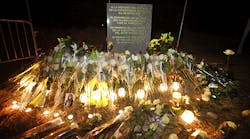In light of evidence that the co-pilot of Germanwings Flight 4U 9525 might have deliberately downed the Airbus A320 that crashed into the French Alps Tuesday, the aviation community is examining its safety standards.
The crash, which killed all 150 passengers and crew, occurred after the pilot left the cockpit and was denied entry by co-pilot Andreas Lubitz, according the black box recording salvaged from the wreckage of the passenger jet.
In the recording, the pilot is heard trying to forcibly gain entry after Lubitz refused to allow him back into the cockpit, during which time the plane made its final descent into the French Alps.
Cockpit doors lock automatically when they are closed, but typically can be opened again after a security code is entered from the outside. However, the doors also can be manually switched into lock mode to prevent unwelcome intruders into the cockpit.
"All airlines in the United States follow similar procedures when opening the cockpit door, which is the most effective tool to safeguard the flight controls and crew and to prevent unauthorized entry to the flight deck,” the Air Line Pilots Association, a pilot union in the U.S. and Canada, said in a statement.
The standard in question, however, is how many people need to be in the cockpit at one time.
“In the United States, at least two crewmembers are required to be present in the cockpit at all times,” ALPA said.
That is not the case universally.
The European Union does not have a two-crew policy in place for its cockpit. But, after the recent crash, German authorities, along with the Lufthansa Group, on Friday announced plans to implement one.
“The airlines of the Lufthansa Group are to adopt a new cockpit occupancy procedure as a precautionary measure. Under the new procedure, two authorized persons must be present in the cockpit at all times during a flight,” the company said in a statement. “The passenger airlines of the Lufthansa Group will adopt the new procedure as soon as possible, in due consultation with their national aviation authority.”
The policy changes have been accompanied by news of potential mental illness of Lubitz.
After a search of Lubitz’s home, German prosecutors said documents – a doctor’s note excusing Lubitz from work the day of the crash and another torn-up doctor’s note – were found that suggest the pilot was hiding a medical condition from his employer.
That revelation raised a lot of concern in a profession repeatedly ranked as one of the most stressful.
While pilots undergo regular medical evaluations, that system certainly isn’t foolproof.
